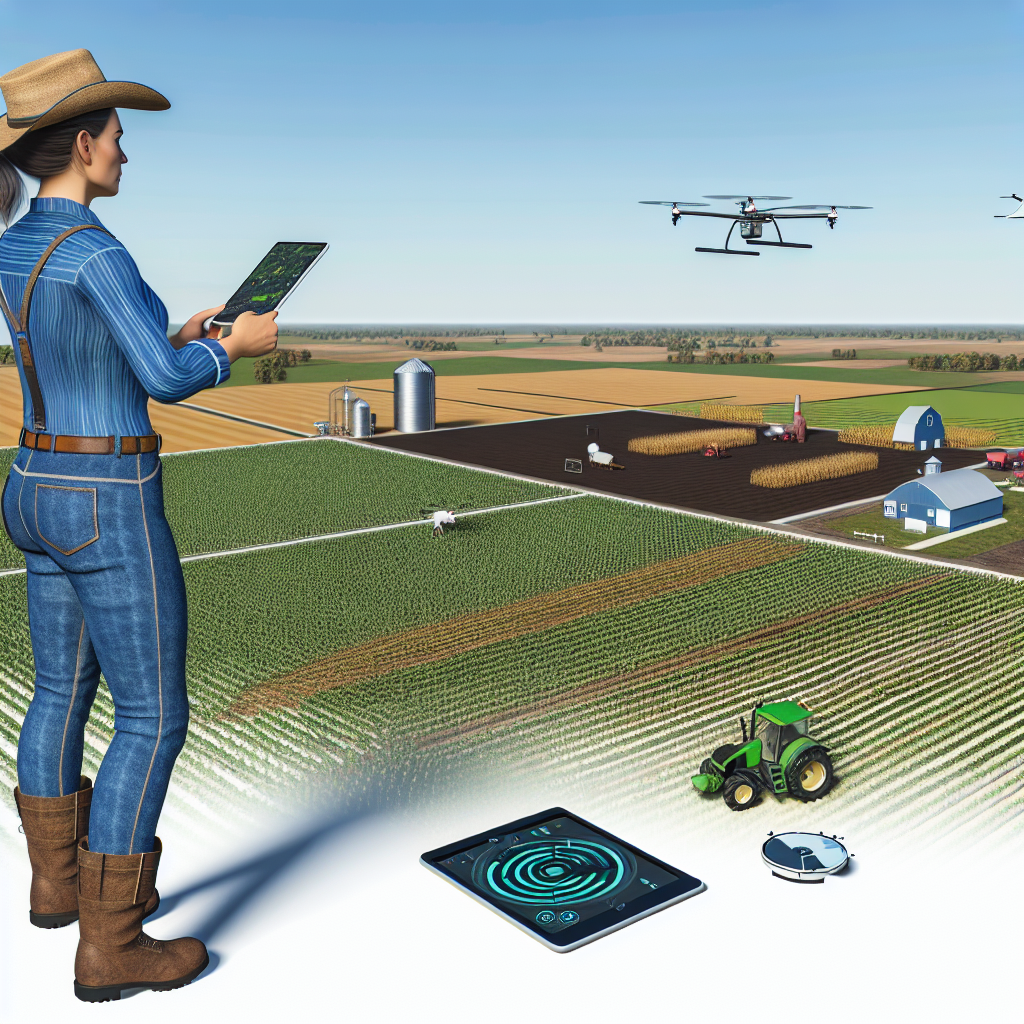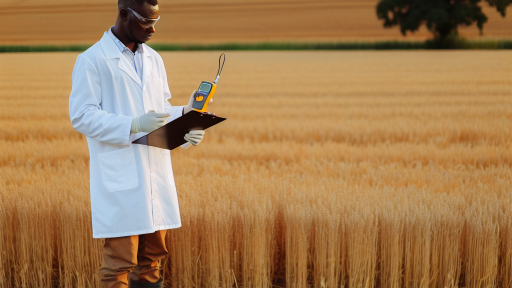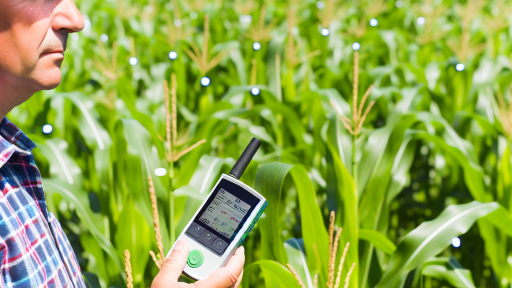Introduction to Farm Management Software
Definition of Farm Management Software
Farm management software is a digital tool that assists farmers.
It streamlines various farming operations and enhances efficiency.
Farmers can manage crops, livestock, and finances using this technology.
Importance of Farm Management Software
Implementing farm management software improves productivity across the board.
It provides valuable insights into operational processes.
Farmers can make informed decisions based on real-time data.
Additionally, it helps in tracking expenses and managing resources effectively.
Benefits of Using Farm Management Software
Farm management software offers numerous advantages to agricultural operations.
- It increases overall efficiency and productivity.
- Users can monitor crop health and yield predictions.
- The software aids in compliance with agricultural regulations.
- Farmers can analyze data trends for better forecasting.
Challenges and Considerations
Despite the benefits, farm management software also comes with challenges.
Farmers need to consider the initial investment costs.
Training may be necessary for staff to use the software effectively.
Moreover, data security and privacy are critical concerns.
Key Features of Effective Farm Management Software
User-Friendly Interface
An effective farm management software should feature a user-friendly interface.
This design allows farmers to navigate the system effortlessly.
Moreover, a simple layout enhances productivity and reduces errors.
Transform Your Agribusiness
Unlock your farm's potential with expert advice tailored to your needs. Get actionable steps that drive real results.
Get StartedReal-Time Data Monitoring
Real-time data monitoring is crucial in modern agriculture.
This feature helps farmers make informed decisions promptly.
It enables users to track crop health, soil conditions, and weather patterns.
Financial Management Tools
Robust financial management tools help track expenses and revenues.
These tools can manage budgets and forecast future profits.
Consequently, users can make strategic financial decisions.
Crop Planning and Management
The software should facilitate effective crop planning.
Crop management features can optimize planting schedules based on trends.
Furthermore, they help in tracking crop yields and performance.
User Support and Training Resources
Access to comprehensive training resources is essential.
Support should include tutorial videos and user guides.
Additionally, responsive customer service enhances user satisfaction.
Integration Capabilities
Integration with existing tools and technologies adds value.
This includes linking with GPS systems and machinery software.
Such integration streamlines operations and reduces redundancy.
Mobile Accessibility
Mobile accessibility allows farmers to manage operations on the go.
This flexibility ensures that farmers stay connected anywhere.
As a result, they can monitor and adjust their activities in real time.
Analytics and Reporting
Analytics tools provide insights into farm performance.
These tools can generate detailed reports on various metrics.
Consequently, farmers can identify trends and areas for improvement.
Benefits of Streamlining Daily Farming Operations with Software Solutions
Improved Efficiency
Farm management software significantly enhances operational efficiency.
By automating routine tasks, farmers save valuable time.
This increases productivity across various farming activities.
Showcase Your Farming Business
Publish your professional farming services profile on our blog for a one-time fee of $200 and reach a dedicated audience of farmers and agribusiness owners.
Publish Your ProfileConsequently, labor costs are reduced, allowing for better resource allocation.
Better Data Management
Software solutions facilitate superior data collection and analysis.
Farmers can monitor crop performance and weather patterns effectively.
Additionally, historical data helps in making informed decisions.
Thus, farmers can identify trends and adjust strategies promptly.
Enhanced Financial Management
Farm management software provides robust financial tracking capabilities.
Farmers can easily manage budgets, expenses, and profits.
Moreover, software can generate comprehensive financial reports.
This insight aids in planning and sustainable financial growth.
Simplified Communication
Effective communication is vital in farming operations.
Software solutions enhance communication between teams and stakeholders.
Real-time updates keep everyone informed and aligned on tasks.
As a result, operations run smoothly and efficiently.
Improved Resource Management
Managing resources effectively is essential for farm profitability.
Software solutions optimize the use of water, nutrients, and equipment.
This leads to reduced waste and lower input costs.
Furthermore, farmers can forecast resource needs accurately.
Increased Regulatory Compliance
Navigating agricultural regulations can be challenging.
Farm management software helps ensure compliance with local laws.
It keeps accurate records, simplifying audits and inspections.
This reduces the risk of penalties and supports sustainable farming practices.
Discover More: Implementing Controlled Environment Agriculture on Your Farm
Selecting the Right Farm Management Software: Factors to Consider
Assess Your Farm’s Needs
Begin by evaluating your specific farm operations.
Consider the crop types and livestock you manage.
Identify which features will enhance your efficiency.
For instance, you may need tools for crop planning or livestock tracking.
Evaluate User-Friendliness
Choose software that is easy to navigate.
A user-friendly interface can save time and reduce errors.
Ensure that staff can quickly adapt without extensive training.
Integration Capabilities
Select software that integrates seamlessly with your existing systems.
This may include accounting software or machinery dashboards.
Proper integration promotes a smoother workflow across your operations.
Budget Considerations
Establish a clear budget for your software investment.
Compare pricing structures among different providers.
Look for software that offers good value for its features.
Support and Training
Ensure the software provider offers comprehensive support.
Access to training materials can also facilitate smoother implementation.
Responsive customer service can help resolve issues quickly.
Reviews and Testimonials
Read reviews from other farmers who have used the software.
Consider their experiences with the software’s functionality.
Showcase Your Farming Business
Publish your professional farming services profile on our blog for a one-time fee of $200 and reach a dedicated audience of farmers and agribusiness owners.
Publish Your ProfilePositive testimonials can guide your decision-making process.
Explore Further: Sustainable Harvesting Techniques Leveraging Advanced Technologies
Implementation Strategies for Farm Management Software
Assessing Farm Needs
Begin by evaluating your current farming operations.
Identify areas that require improvement.
Consider specific tasks that could benefit from automation.
Engage your team in the assessment process.
Gather feedback from all levels of staff.
Ensure you understand the goals you want to achieve.
Selecting the Right Software
Research various farm management software options.
Look for features that align with your identified needs.
Compare pricing and subscription models.
Read user reviews and case studies for insights.
Request demonstrations to see software in action.
Check for integration capabilities with existing systems.
Developing an Implementation Plan
Create a detailed implementation plan once you select a software.
Define roles and responsibilities within your team.
Set measurable goals and timelines for deployment.
Prepare a budget that includes training and support.
Communicate the plan to all stakeholders for transparency.
Training Your Team
Provide comprehensive training for employees using the software.
Utilize vendor resources, such as online tutorials and webinars.
Encourage hands-on learning through practice sessions.
Schedule regular check-ins to assess progress and understanding.
Modify training based on user feedback and performance.
Monitoring and Evaluation
After implementation, consistently monitor software performance.
Evaluate whether it meets the initial goals set for it.
Gather ongoing feedback from team members using the software.
Adjust workflows to improve efficiency as needed.
Regularly review software updates and new features for potential benefits.
Ensuring Long-Term Success
Maintain open lines of communication regarding software use.
Stay informed about industry trends that may impact software features.
Encourage a culture of continuous learning within your team.
Consider periodic refresher training sessions to enhance skills.
Foster a collaborative environment for sharing best practices.
See Related Content: Sustainability In Agriculture Through Blockchain Supply Chains
Case Studies: Successful Adoption of Farm Management Software in Different Farming Types
Crop Farming
Green Valley Farms implemented farm management software to enhance productivity.
This software allowed them to monitor crop health in real-time.
Consequently, they increased overall yields by 20% within a year.
Their data-driven approach also helped reduce input costs significantly.
Moreover, they improved their pest management strategies effectively.
Showcase Your Farming Business
Publish your professional farming services profile on our blog for a one-time fee of $200 and reach a dedicated audience of farmers and agribusiness owners.
Publish Your ProfileDairy Farming
Lakeside Dairy began using farm management software to track herd health.
This technology enabled better feeding strategies based on individual needs.
As a result, they saw a 15% increase in milk production.
Additionally, the software facilitated scheduling veterinarian visits more efficiently.
Lastly, they simplified record-keeping, making compliance easier.
Poultry Farming
Sunny Acres Poultry implemented software to automate daily operations.
This system helped monitor feed conversion rates closely.
As a consequence, they reduced feed costs by 10% within six months.
The farm also benefited from improved tracking of environmental conditions.
With better analytics, they optimized their production cycles effectively.
Vegetable Farming
Fresh Fields used farm management software to streamline planting schedules.
They gained insights into optimal planting times through data analysis.
This approach increased their harvest quality and reduced waste significantly.
Efficient resource management became a key priority for the farm.
Ultimately, they established a more sustainable growing practice.
Mixed Farming
Country Roots Farm adopted software to integrate various farming practices.
This integration enhanced coordination between crop and livestock operations.
Consequently, they maximized land use effectiveness across the farm.
The software provided valuable reports on profitability across different sectors.
Moreover, it improved labor management, leading to higher overall efficiency.
Uncover the Details: Choosing The Right GMO Crops For Your Farm

The Future of Farm Management Software: Trends and Innovations to Watch
Integration of AI and Machine Learning
Farm management software increasingly incorporates AI technologies.
These systems analyze data to enhance decision-making.
Farmers utilize AI for precision agriculture techniques.
For instance, predictive analytics help in crop management.
Additionally, smart irrigation systems optimize water use.
Mobile Applications for On-the-Go Management
Mobile apps revolutionize farm management tasks.
Farmers can access critical data anytime and anywhere.
This flexibility improves productivity significantly.
Moreover, real-time communication enhances collaboration.
Farm managers stay informed about field conditions instantly.
Data-Driven Insights for Better Decision Making
Data analytics has become essential in farming today.
Farm management software collects vast amounts of data.
This data yields valuable insights into farm operations.
Farmers can optimize inputs and reduce waste with this information.
Furthermore, they can analyze weather patterns and trends.
Enhanced User Interfaces and User Experience
Modern software includes user-friendly interfaces.
Ease of use increases adoption among farmers.
Intuitive design helps users navigate features efficiently.
Training costs decrease as user experience improves.
Showcase Your Farming Business
Publish your professional farming services profile on our blog for a one-time fee of $200 and reach a dedicated audience of farmers and agribusiness owners.
Publish Your ProfileAdditionally, customization options enable tailor-made solutions.
Cloud-Based Solutions for Connectivity and Scalability
Cloud computing offers numerous advantages for farmers.
Remote access fosters connectivity across multiple devices.
Farmers can easily scale their operations without limitations.
Data storage and backup become more reliable with cloud systems.
Collaboration between different stakeholders also improves.
Collaborations with Agricultural Tech Startups
Partnerships with tech startups drive innovation in agriculture.
Farm management software continually evolves to meet emerging needs.
Startups often introduce breakthrough technologies and solutions.
Farmers benefit from cutting-edge tools for improved performance.
This collaborative environment fosters a culture of innovation.
Challenges and Solutions in Adopting Farm Management Software
Understanding Common Challenges
Farmers often face resistance to adopting new technology.
They may struggle with the complexity of software systems.
Moreover, a lack of technical skills can hinder effective usage.
Additionally, some may worry about the costs associated with implementation.
Overcoming Resistance to Change
To combat resistance, education plays a vital role.
Workshops can introduce farmers to the benefits of software.
Sharing success stories from peers can further encourage adoption.
Addressing Technical Complexity
Simplifying user interfaces can make software more accessible.
Moreover, providing clear tutorials and support can aid new users.
Software companies should consider user feedback for improvements.
Managing Costs Effectively
Farmers can explore free trials before making a commitment.
Additionally, comparing different software solutions may reveal cost-effective options.
Investing in software can lead to long-term savings and efficiency.
Enhancing Technical Skills
Regular training sessions can significantly improve proficiency.
Farmers should also consider collaborative learning groups.
Online tutorials are a convenient way to boost technical knowledge.
Integration of Farm Management Software with IoT and Smart Agriculture Technologies
Enhancing Data Collection
Farm management software significantly improves data collection methods.
By integrating with IoT devices, farms can gather real-time data efficiently.
Sensors monitor soil moisture, temperature, and crop health continuously.
This data enables farmers to make timely and informed decisions.
Improving Decision-Making
Real-time insights enhance operational decision-making processes.
Farm management software processes data and suggests actionable outcomes.
For instance, it can recommend irrigation adjustments based on moisture levels.
Such responsive actions can optimize resource usage and increase yields.
Streamlining Operations
Integrating IoT and farm management software streamlines daily operations.
Farmers can manage tasks such as planting, watering, and harvesting more effectively.
Automated systems reduce the burden of manual labor significantly.
This efficiency allows farmers to focus on strategic growth areas.
Enhancing Crop Monitoring
Smart agriculture technologies provide enhanced crop monitoring capabilities.
Showcase Your Farming Business
Publish your professional farming services profile on our blog for a one-time fee of $200 and reach a dedicated audience of farmers and agribusiness owners.
Publish Your ProfileDrones equipped with cameras can survey large fields quickly.
Farm management software integrates these visuals for better analysis.
Farmers can identify problem areas before they affect yields.
Facilitating Resource Management
Resource management becomes more efficient with integrated technologies.
Farmers can track water, fertilizers, and pesticide usage accurately.
This tracking allows for precise applications, reducing waste and costs.
Ultimately, it leads to more sustainable farming practices.
Improving Financial Management
Farm management software aids in better financial oversight.
The integration helps track expenses and profits in real-time.
Farmers can generate reports that inform financial planning and strategies.
Such insights empower farmers to allocate resources more wisely.
Encouraging Sustainable Practices
The combination of IoT and farm management tools encourages sustainable agriculture.
Using data-driven insights reduces environmental impacts significantly.
Farmers can implement practices that enhance soil fertility and biodiversity.
This approach meets the growing consumer demand for sustainably sourced products.
Additional Resources
USDA Announces New Opportunities to Improve Nutrient …
U.S. Department of Agriculture, Farm Service Agency | Home | Farm …




